导游资格考试英语导游词:日本
导游词日语
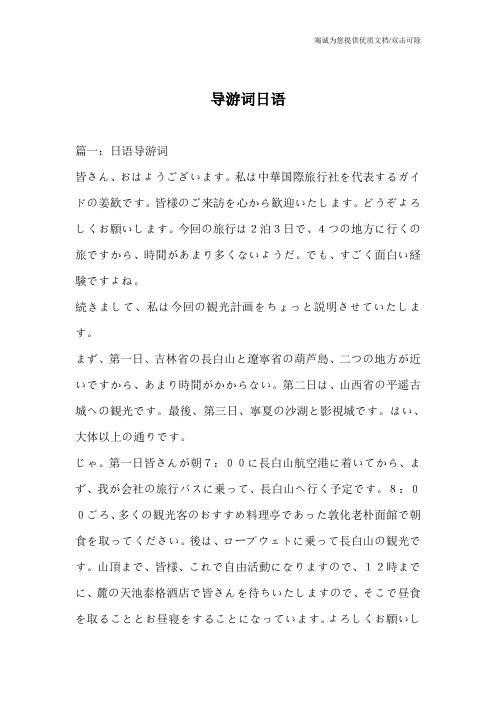
导游词日语篇一:日语导游词皆さん、おはようございます。
私は中華国際旅行社を代表するガイドの姜歓です。
皆様のご来訪を心から歓迎いたします。
どうぞよろしくお願いします。
今回の旅行は2泊3日で、4つの地方に行くの旅ですから、時間があまり多くないようだ。
でも、すごく面白い経験ですよね。
続きまして、私は今回の観光計画をちょっと説明させていたします。
まず、第一日、吉林省の長白山と遼寧省の葫芦島、二つの地方が近いですから、あまり時間がかからない。
第二日は、山西省の平遥古城への観光です。
最後、第三日、寧夏の沙湖と影視城です。
はい、大体以上の通りです。
じゃ。
第一日皆さんが朝7:00に長白山航空港に着いてから、まず、我が会社の旅行バスに乗って、長白山へ行く予定です。
8:00ごろ、多くの観光客のおすすめ料理亭であった敦化老朴面館で朝食を取ってください。
後は、ロープウェトに乗って長白山の観光です。
山頂まで、皆様、これで自由活動になりますので、12時までに、麓の天池泰格酒店で皆さんを待ちいたしますので、そこで昼食を取ることとお昼寝をすることになっています。
よろしくお願いします。
あのう、午後2:00はホテルから出発し、バスで葫芦島の方へまいります。
登山活動の後、皆様お疲れているところに、午後4:00、私たちが葫芦島の温泉リゾートホテルに着いて、温泉に入って、自由に享受することができる。
夜になると海岸地帯には、焚き火がありますので、ここに住んでいる人々は、夏には、よく焚き火を囲み、短夜を踊り明かす風習があるよ、もし皆様が興味があったら、花火を見ながら、焚き火を囲み、彼らと一緒に踊ってもいいですよ。
ええと、夕食といえば。
地元の海老やカニや法螺貝など、そして、あんすの中味を入ったお粥もおすすめの美食でございます。
宿泊は海逸休日酒店にします。
それから、二日目は、飛行機の時間が朝7:00ですから、ホテルの出発時間は6:00でございます。
名古屋英文导游范文

名古屋英文导游范文Nagoya, the fourth-largest city in Japan, is a thriving metropolitan area that offers a unique blend of traditional Japanese culture and modern urban experiences. As a major industrial and commercial hub, the city boasts a rich history, diverse architectural landmarks, and a vibrant culinary scene that make it a must-visit destination for any traveler to Japan.One of the city's most iconic landmarks is Nagoya Castle, a stunning 17th-century castle that has been meticulously restored to its former glory. Visitors can explore the castle's ornate interiors, including the impressive Honmaru Palace, and climb to the top of the main tower for panoramic views of the city. The castle grounds also feature beautiful gardens and a museum that showcases the region's history and cultural heritage.Another must-see attraction in Nagoya is the Atsuta Shrine, one of the most important Shinto shrines in Japan. The shrine is believed to house the sacred sword, one of the three Imperial Regalia of Japan, and has been a site of pilgrimage for centuries. Visitors can strollthrough the serene grounds, observe the traditional ceremonies, and explore the various shrines and temples that make up this sacred complex.For those interested in Japanese automotive history, the Toyota Commemorative Museum of Industry and Technology is a must-visit destination. This state-of-the-art museum chronicles the evolution of Toyota's manufacturing processes, from the company's humble beginnings as a loom manufacturer to its current status as a global automotive giant. Visitors can learn about the innovative technologies that have shaped the automotive industry and even take a guided tour of the factory floor to see the production process in action.One of the highlights of any visit to Nagoya is the city's vibrant food scene. Nagoya is renowned for its delicious local cuisine, including the iconic miso-based dish called Misokatsu, which features deep-fried pork cutlets in a rich, savory sauce. Visitors can explore thecity's bustling markets, such as the Osu Kannon Shopping District, to sample a variety of traditional Japanese street foods, from takoyaki (octopus balls) to okonomiyaki (savory pancakes).For those seeking a more upscale dining experience, Nagoya is home to a number of high-end restaurants that showcase the region's culinary excellence. One such establishment is the Michelin-starredrestaurant Hamashita, which offers exquisite Japanese kaiseki cuisine in a serene, traditional setting.Beyond its cultural and culinary attractions, Nagoya is also a hub of modern architecture and design. The city is home to the Nagoya City Science Museum, a striking building designed by the renowned architect Kisho Kurokawa, which features a unique, futuristic-looking exterior. Visitors can explore the museum's interactive exhibits on science, technology, and the environment, as well as enjoy the building's stunning architectural features.Another architectural highlight is the Nagoya Station, a modern transportation hub that seamlessly blends traditional Japanese design elements with cutting-edge technology. The station's soaring glass and steel structure, combined with its intricate network of underground passages and shopping malls, make it a truly impressive sight to behold.For those looking to experience the city's vibrant nightlife, Nagoya offers a range of options, from lively izakaya (Japanese-style pubs) to chic cocktail lounges and live music venues. One popular destination is the Sakae district, which is known for its bustling streets, neon-lit signs, and a diverse array of dining and entertainment options.Throughout the city, visitors will also find a wealth of opportunitiesto immerse themselves in Nagoya's rich cultural heritage. The city is home to numerous museums and art galleries that showcase the region's traditional arts and crafts, including the Nagoya/Boston Museum of Fine Arts, which features a impressive collection of Japanese and international artworks.For those interested in exploring the natural beauty of the region, Nagoya is surrounded by stunning landscapes, including the picturesque Chukyo region, which is renowned for its rolling hills, lush forests, and serene lakes. Visitors can take day trips to nearby destinations, such as the Inuyama Castle, a UNESCO World Heritage Site that offers panoramic views of the Kiso River, or the Korankei Gorge, a breathtaking autumn foliage spot that attracts visitors from around the world.Overall, Nagoya is a city that offers a rich and diverse range of experiences for travelers. Whether you're interested in exploring the city's cultural heritage, indulging in its delicious cuisine, or immersing yourself in its modern architectural wonders, Nagoya has something to captivate and delight visitors of all interests and backgrounds. With its convenient location and excellent transportation links, Nagoya is an ideal starting point for exploring the many wonders of central Japan.。
日本大阪导游词

日本大阪导游词日本大阪导游词作为一名可信赖的导游人员,可能需要进行导游词编写工作,导游词是讲解当地的基本情况,介绍风土人情的文章。
那么导游词应该怎么写呢?下面是小编为大家收集的日本大阪导游词,欢迎阅读与收藏。
日本大阪导游词1各位朋友:大家好!我是大家这次旅行的导游,欢迎诸位来日本大阪城公园参观游览。
大阪城公园是位于大阪市中央区的大型绿地公园,园内有森林公园、大阪城音乐堂、棒球场等设施。
大阪城体育馆是西日本最大的体育馆,经常在此举办演唱会、体育活动、国际会议,或各种大型活动。
在大阪城公园中央耸立的天守阁更是眺望整个大阪城全景的好地方,在不少外国游客心中是非常受欢迎的景点。
日本,位于亚洲东部,陆地面积约37.79万平方公里,由本州、四国、九州、北海道四个大岛及周围七千二百多个小岛屿组成,因此也被称作“千岛之国”。
日本是一个文化色彩浓郁的国家,且旅游资源丰富,已形成其亚洲的独特风格,是外国游客来亚洲旅游的重要一站。
大阪市位于日本本州西部,是日本第二大城市。
说到大阪的象征性景点之一,那不得不提到历史悠久的大阪城与城内的'天守阁了,它们都坐落在市中心的大阪城公园内。
日本历史古迹——大阪城大阪城是十六世纪丰臣秀吉为了与德川家康进行战争而建造的,主要由石墙所砌造,是当今日本重要的历史古迹。
大阪城外观五层,内部八层,高五十五米,除第八层为了望台外,其余几层皆为资料馆。
城墙四周建有护城河,附近有风景秀丽的庭园和亭台楼阁。
漫步河边,奇花异卉,满目青翠,充满诗情画意。
现存的大阪城公园于1931年由民间集资重建,为后人仿制丰臣秀吉时期的天守阁重制的。
大阪城天守阁这座宏伟的天守阁就耸立在大阪城公园内城中央,它是日本战国时期修建的大型城堡,如今成为大阪城的主体建筑。
整个建筑镶铜镀金,显得格外气派。
登上高五层八阶的天守阁,甚至可以了望整个大阪市的繁荣景象。
大阪城历史博物馆在城内的历史博物馆里保存有丰臣秀吉的木像、武器和美术作品等,是作为史迹的大阪城中非常珍贵的象征。
导游资格证考试英文导游词

导游资格证考试英文导游词以下是一份英文导游词示例,供您参考:Welcome to our beautiful city, known as the "City of Flowers".I am your guide for this tour, and I will be with you every step of the way.Our first stop is the famous "Flower Market". Here, you can see a variety of flowers, both familiar and rare, arranged in beautiful bouquets. Feel free to take some time to smell the flowers and appreciate their beauty.Next, we will visit the "Botanical Gardens". These gardens are home to a wide range of plants, including trees, shrubs, and herbs. Here, you can learn more about the different species and their unique features.After that, we will head to the "Zoo". The zoo is home to a variety of animals, including elephants, tigers, and monkeys. As we walk through the zoo, I will tell you more about the animals and their habitats.Finally, we will visit the "Museum of Natural History". Here, you can see exhibits that showcase the natural history of our region, including fossils, minerals, and dinosaur skeletons. This is a great place to learn more about the natural world. Thank you for joining me on this tour. I hope you have enjoyedyourself and have gained a deeper understanding of our beautiful city's history and culture.。
英语导游词范文100(范文)

英语导游词范文100英语导游词范文100篇一:导游英语_100句导游口语 Meeti ng Guests迎接客人1. ele t Chi na! 欢迎您到中国来!2.Did yu hav e a gd tri p? 旅行愉快吗?3. Yuall need a gd rest f irst. 你们都需要先休息一下。
4. Is ev eryne in t he grup he re? 全团的人都在吗?5. S hall I hel p yu ith y ur luggage? 让我来帮您拿行李好吗?6.The shuttl e bus is j ust aiting in the pa rking lt.大巴正在停车场等位。
n the ayt the Htel至饭店途中7. Is ever ybdy n the bus? 每个人都在车上了吗?8. Shall e g n? 我们现在可以出发了吗? 9. Let me intrducemy team tyu first.首先让我来向大家介绍一下我的团队。
10. It’s ne f thebest fur-s tar htelsin the cit y. 它是这个城市最好的四星级酒店之一。
11. Ihpe yu ill enjy yurstay there. 我希望你能在那住得愉快。
12. Next, I’d like tintrduce s mething ab ut this ci ty. 接下来,我想要介绍一下有关这个城市的一些情况。
13. I’mafraid yuneed a gdrest first. 恐怕你得先休息。
14. L et’s get f f and g tthe recept in desk. 让我们下车去接待处。
导游资格考试英语导游词:东京
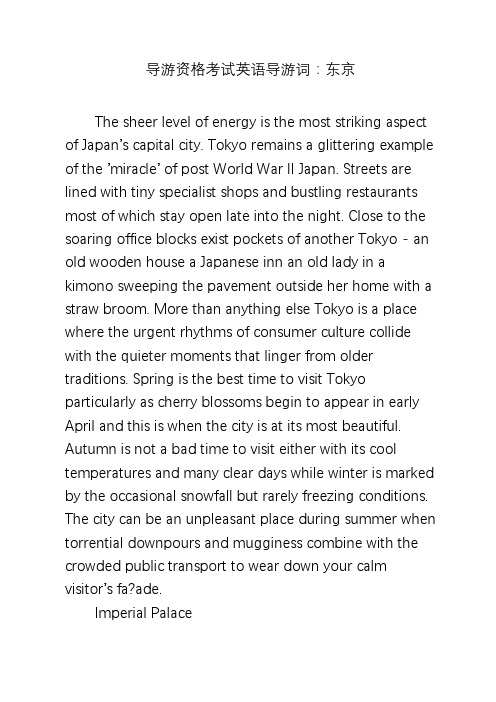
导游资格考试英语导游词:东京The sheer level of energy is the most striking aspect of Japan’s capital city. Tokyo remains a glittering example of the ’miracle’ of post World War II Japan. Streets are lined with tiny specialist shops and bustling restaurants most of which stay open late into the night. Close to the soaring office blocks exist pockets of another Tokyo - an old wooden house a Japanese inn an old lady in a kimono sweeping the pavement outside her home with a straw broom. More than anything else Tokyo is a place where the urgent rhythms of consumer culture collide with the quieter moments that linger from older traditions. Spring is the best time to visit Tokyo particularly as cherry blossoms begin to appear in early April and this is when the city is at its most beautiful. Autumn is not a bad time to visit either with its cool temperatures and many clear days while winter is marked by the occasional snowfall but rarely freezing conditions. The city can be an unpleasant place during summer when torrential downpours and mugginess combine with the crowded public transport to wear down your calm visitor’s fa?ade.Imperial PalaceThe Japanese emperor and the imperial family still call the Imperial Palace home so unless you get a royal invite to tea tourists are restricted to the outskirts and the gardens. New Year’s Day (2 January) and 23 December (the Emperor’s birthday) are the only exceptions to this rule.The biggest draw card of the Imperial Palace both literally and metaphorically is Edo-jo castle. From the17th century until the Meiji Restoration it was used as the impregnable fortress of the ruling shogun ate. Over the years the castle was upgraded added to renovated and built onto with all the force of a rabid renovator. For a while it was the largest castle in the world but all the DIY’ing came to an abrupt end when large portions of it were destroyed in the transfer of power from shogun back to emperor during the Meiji Restoration.The Imperial East Garden is entered through one of three gates although the most popular is the Ote-mon which was once the principle gate of Edo-jo. The garden is an oasis of quiet after the bustle of Tokyo and characteristically Japanese; a horizon of clear lines an attention to detail and the religious placement of obxxxxjects within the landscape.Tokyo DisneylandYou could be forgiven for assuming that the country that invented fake waves would jump at the chance to out-Disney Disneyland so it comes as something of a shock to see such uncharacteristic restraint. Surprisingly Mickey Mouse Donald Duck and most of Walt’s other empire-building prototypes have been respectfully left alone and much of Tokyo Disneyland is an exact replica of the Californian amusement park.ShinjukuThe Shinjuku district is without doubt the most vigorous part of Tokyo; two million people per day pass through Shinjuku station alone. With a total lack of irony or tongue-in-cheekness the two sides - east and west - sit side-by-side in mutual harmony; west Shinjuku is the staid buttoned-down commercial hub of the city while the east is its colourful seedy and exotic counterpart. The west is planned administrative and skyscrapped while the east side is rambling chaotic and full of fast-food shops and pawn shops.Wandering the east side y ou’ll be able to see the entire world go by while simultaneously having your senses assaulted by archetypal Blade Runner video billboards on the Studio Alta building a popular meeting place for Tokyoites. Other east-side attractions includeHanazona-jinja shrine the many departmemt stores and the colourful if risque Kabukicho and Golde.Sony BuildingThe Sony building at the Sukiyabashi intersection is a must-see for all the cyberjunkies digital-devotees and Playstation groupies. Any electronic gizmo that has ever been invented is here in the Sony building as well as some yet-to-be-retailed prototypes. With most of the displays being a hands-on proposition it’s an oversized kid’s arcade.The building itself is a rather phlegmatic version of the sixties - a lot of function over form - but with eight stories of unadulterated electronic heaven who cares about the packaging.GinzaDespite its disaster-ridden history and propensity for shape-changing Ginza has become synonymous with conspicuous consumption and excessive shopping. At the end of the 19th century after fire razed it to the ground it was ressurected in a London-cum-faux-Parisian style with brick buildings and wide boulevards that mimicked the Champs Elysses. Since then earthquakes and WWII carpet-bombing has seen it gradually transform from continental chic to trans-atlantic functional but it still pulls the crowds.There are some jejeune shopping districts that have tried to wrestle the crown from Ginza - they’re more crowded more opulent and hipper - but the grande old dame of ostentatious spending stills retains her imperious snob value. Serious shoppers don’t leave town without swinging through the doors of Matsuya Mitsukosh and Wako department stores. The Ginza strip is where you can purchase novelty items whose fetishistic value far outweigh its functional value and indulge in a spot of retail therapy. Window shopping is free though and the window displays in the department stores are works of installation art in themselves.Ueno-koen parkIf Ginza is for shopping Ueno-koen Park is for strolling museum-hopping and temple-gazing. The area of Ueno was historically the Alamo of the last shogunate - site of his futile last-ditch effort to prevent a takeover by the imperial army. Today it’s a carefully landscaped park dotted with museums temples and a not-half-bad zoo.Attractions inside the park include the Tokyo Metropolitan Museum of Art (if contemporary art is your bag this is a good place to start) the Tokyo National Museum the National Science Museum the National Museum of Western Art (not only does the buildinghouse some impressive examples of western art the building itself was built by Le Corbusier and the garden contains original Rodins including his iconic sculptureThe Thinker) the Tokyo Metropolitan Festival Hall and the Ueno-no-Mori Art Museum which often has calligraphy exhibitions scheduled.One of the most frequently and fervently patronised temples in Ueno-koen park is the Kiyomizu Kannon-do Temple. Women wishing to conceive leave a doll here for the 1000-armed goddess senju Kannon; after the dolls are burnt in an annual bonfire on 25 September the women wait to see if Kannon has granted them the giftof fertility.Hama Rikyu Detached Palace GardenThe Hama Rikyu Detached Palace Garden south of Tokyo central is 25 hectares (62 acres) of Tokyo’s greenest and most finely landscaped pieces of real estate. In the 17th century it was the happy hunting ground for the Tokugawa shogunate but passed into the hands of the good citizens of Tokyo post World War II. The park is actually on an island cut off from the surrounding metropolis by an ancient walled moat and accessible by only one entrance over the Nanmon Bridge.The Park is a popular venue for a stroll because it feels deceptively large and has an unusual emphasis onwater. The huge Shiori Pond is a focal point for visitors but its tidal pools teahouses bridges pine trees and pavilions for moon-watching all contribute to the garden’s charm and photogenic appeal.An entry fee ensures that the Hama Rikyu is one of the quieter and less-congested areas of Tokyo although the US’3 entry fee is waived for disabled travellers and one companion.Tokyo National MuseumThe Tokyo National Museum is one place worth going out of your way to visit. It holds Japan’s largest collection of Japanese art as well as a number of fine sculptures and a not inconsiderable number of antiquities. Only a fraction of the collection is displayed at any one time.The four main galleries - the Main Gallery the Gallery of Eastern Antiquities Hyokeikan Hall and the Gallery of Horyu-ji Treasures - hold Japanese art (including sculpture swords lacquerware and calligraphy) archaelogical finds from throughout Asia Japanese archaelogical items and masks and scrolls respectively.The Gallery of Horyuji Treasures is only open on Thursdays and even then if it is raining or humid can be summarily closed. Some of the galleries exhibits are over1000 years old and great care is taken to protect them from the effects of humidity and dampness.Kite MuseumThe Kite Museum just behind Tokyu department store in Shibuya-ku is living reproof to all those rinky-dink kites with plain plastic sails ply wood frxxxxames and a Sunday driver at the end of the string. Most of the 4000 kites housed in the museum are traditional Japanese kites (Edo Nishiki-E Dako) but there are some fine examples from China and other Asian countries.The frxxxxames are mainly bamboo while the sails are made of ’washi’ a type of handmade p aper made from the kohzo tree (a species of mulberry). The paper is both lightweight and strong. Illustrations are first outlined in dark sumi ink to restrict the pigments to the desired areas and then the artist goes to town on the design itself. Kite scenes include scowling Kabuki actors samurai warriors hacking each other to death against a busy backdrop of psychedelic swirls and cute fluffy ’Hello Kitty’ type animals doing unnatural things.The museum is situated on the 5th floor of Taimeiken a well-known restaurant located in downtown Tokyo. It’s cramped and pokey and lacks explanatory material but its still a unique museum with a unique collection.Tokyo is serviced by two major airports Narita and Haneda. There are 12 subway lines operated by two companies. The subway services are essentially the same and have good connections from one to the other although they do operate under separate ticketing systems. Driving is possible in Tokyo but not without its frustrations jams and high tolls. Unless you’re heading out of town stick to public transport. The same rule applies to the city’s expensive taxis. Generally speaking the traffic system in Tokyo is good. How about planning your trip to Tokyo right now? You will not regret.。
日本导游词——精选推荐
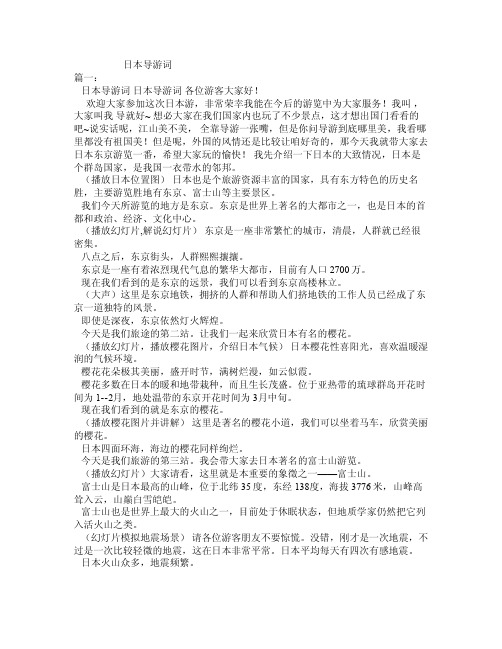
日本导游词篇一:日本导游词日本导游词各位游客大家好!欢迎大家参加这次日本游,非常荣幸我能在今后的游览中为大家服务!我叫,大家叫我导就好~ 想必大家在我们国家内也玩了不少景点,这才想出国门看看的吧~说实话呢,江山美不美,全靠导游一张嘴,但是你问导游到底哪里美,我看哪里都没有祖国美!但是呢,外国的风情还是比较让咱好奇的,那今天我就带大家去日本东京游览一番,希望大家玩的愉快!我先介绍一下日本的大致情况,日本是个群岛国家,是我国一衣带水的邻邦。
(播放日本位置图)日本也是个旅游资源丰富的国家,具有东方特色的历史名胜,主要游览胜地有东京、富士山等主要景区。
我们今天所游览的地方是东京。
东京是世界上著名的大都市之一,也是日本的首都和政治、经济、文化中心。
(播放幻灯片,解说幻灯片)东京是一座非常繁忙的城市,清晨,人群就已经很密集。
八点之后,东京街头,人群熙熙攘攘。
东京是一座有着浓烈现代气息的繁华大都市,目前有人口2700万。
现在我们看到的是东京的远景,我们可以看到东京高楼林立。
(大声)这里是东京地铁,拥挤的人群和帮助人们挤地铁的工作人员已经成了东京一道独特的风景。
即使是深夜,东京依然灯火辉煌。
今天是我们旅途的第二站。
让我们一起来欣赏日本有名的樱花。
(播放幻灯片,播放樱花图片,介绍日本气候)日本樱花性喜阳光,喜欢温暖湿润的气候环境。
樱花花朵极其美丽,盛开时节,满树烂漫,如云似霞。
樱花多数在日本的暖和地带栽种,而且生长茂盛。
位于亚热带的琉球群岛开花时间为1--2月,地处温带的东京开花时间为3月中旬。
现在我们看到的就是东京的樱花。
日本富士山英文导游词

日本富士山英文导游词篇一:日本富士山英文介绍Fujisan‘’Fujisan’’(富士山·ふじさん)meansmountFuji,isthehighestmountaininJapanat3,776.24m(12,389ft).a longwithmountTateandmountHaku,itisoneofJapan's”ThreeHolymou ntains”(三霊山,Sanreizan).anactivestratovolcanothatlasteruptedin1707–08,mountFujii sjustwestofTokyo,andcanbeseenfromthereonaclearday.mountFuji'se xceptionallysymmetricalconeisawell-knownsymbolofJapananditisfrequen tlydepictedinartandphotographs,aswellasvisitedbysightseersandclimbers. nameinEnglish,themountainisknownasmountFuji.Somesourcesrefertoitas”Fujiyama”and“Fuji-san”.”Fujiyama”isanincorrectreadingofthecharactersusedtospellthemountainitself.Japanesespeakersrefertothemountainas”Fuji-san”.This”-san”suffixisnotthehonorificusedwithpeople'snames,suchaswatanabe-san,butrathertheon'yomireadingofthecharacter山yama(meansmountaininEnglish)usedincompounds.語源富士山は、古文献では不二山もしくは不尽山と表記される。
WangXizhiJP王羲之故居 导游词日语

観光エリア中国語名:
観光エリア英語名:
観光エリア韓国語名:
観光エリア日本語名:
王羲之旧居
観光エリア概況:
臨沂の市街地に位置する。旧居のエリア内には洗硯池、晒書台、晋墨斎、書院と名書道家の碑の回廊などがある。ここでは、「書道の聖人」の筆跡、碑文および現代の著名な書道家の作品を鑑賞することができ、中国の書道の「肉親捜し」のような旅ができる。
王羲之の旧居は臨沂の市街地にあって、敷地面積51ムーある。
観光エリアランク付け:
非A級( )A級()AA級( )
AAA級()AAAA級( )AAAAA級( )
住所:
郵便番号:
駐車場面積: (㎡)
所在都市:
所在区県:
お問い合わせ電話:
ファックス:
ホームページ:
メールアドレス:
個人客入園料:
団体客入園料:
適宜観光者:
適宜季節:
開園時間:
交通機関案内:
エリア内、周辺の宿泊施設:
エリア内、周辺の飲食施設:
観光エリアのイベント情報:
お勧め観光ルート:
観光案内(お客様サービスセンター、お勧め料理、安全保障、お勧めスポット等):
英语导游词万能模板

英语导游词万能模板欢迎词:Ladies and Gentlemen,Welcome to our city! I am your tour guide, (your name). It is my great pleasure to accompany you on this journey.女士们,先生们,欢迎来到我们的城市!我是你们的导游,(你的名字)。
我很荣幸能陪伴你们进行这次旅行。
介绍自己:My name is (your name), a local guide with years of experience in tourism. I have a deep understanding of our city's history, culture, and attractions. I will do my best to make your trip enjoyable and memorable.我叫(你的名字),是一名有着多年旅游经验的当地导游。
我对我市的历史、文化和景点有深入的了解。
我会尽我最大的努力让您的旅行愉快且难忘。
介绍行程:Today, we will visit (attraction name). It is one of the most famous tourist spots in our city. We will start at (time), and the tour will last for about (duration).今天,我们将参观(景点名称)。
这是我们市最著名的旅游景点之一。
我们将在(时间)开始,旅程将持续大约(持续时间)。
介绍景点:(Attraction name) is a place of great historical significance. It was built in (year) by (person or group). The architecture is unique and the scenery is breathtaking.(景点名称)是一个具有重大历史意义的地方。
导游资格考试英语导游词整理

让知识带有温度。
导游资格考试英语导游词整理导游资格考试英语导游词Walt and Roy Disney began their partnership on October 16, 1923 when they signed a contract to produce the Alice Comedies, a series of six- to eight-minute animated films, or shorts, combining live-action and animation. What began as the Disney Brothers Studio evolved into The Walt Disney Company.Throughout the decades, the company has expanded worldwide from shorts to feature-length animated and live-action films and television production; character merchandise licensing; consumer products retailing; book, magazine and music publishing; Internet activities; television and radio broadcasting; cable television programming; and the operation of theme parks and resorts.From the creation of Oswald the Lucky Rabbit in 1927 and the debut of Mickey Mouse in 1928 to the premiere of Tarzan in 1999, animation has remained the defining signature of the company. Along the way, Disney has added successful TV shows like Who Wants To Be A Millionaire, opened theme parks in California, Florida, France and Japan, launched more than 700 Disney Stores and added brands such as Touchstone, Miramax, ABC and ESPN to the fold.To make the most of Disneyland - the ultimate escapist fantasy and the blueprint for imitations worldwide - throw yourself right into it. Don’t think twice about anything and go on every ride you can. The high admission price ($36) includes them all, although during peak periods each one can entail hours of queueing. Remember, too, that the emphasis第1页/共3页千里之行,始于足下。
日语导游词开场白(共8篇)
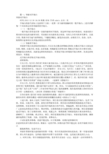
篇一:导游词开场白导游词开场白时间:2011-12-28 16:30来源:未知作者:admin 点击: 次开场白的技巧实际上包括两个方面:一是第一次与游客接触时的一般开场白,二是在讲解每一个具体景点时的导游辞的开场白。
(一)一般开场白一般开场白常常是在第一次接待游客时开始的,而这种开场白也叫欢迎词。
欢迎词的主要内容应该包括向游客问好,代表旅行社向游客表示欢迎,向客人介绍司机和车牌号,自我介绍,简要介绍当地气候等情况,下榻饭店概况,游览活动安排,必要的卫生、饮食、安全、购物等注意事项以及其他必要的内容等等。
(二)导游辞开场白导游辞开场白从结构的角度划分,可以分为完整式和简略式两类:完整式开场白大致包括问候、寒暄、自我介绍、欢迎、良好祝愿、明确游览目的等内容;简略式开场白至少要有问候、明确游览目的两项。
从游览过程的角度划分,有预设开场白和现场开场白两种。
从表达的角度划分,有叙述式开场白和抒情式开场白两类。
请看案例:①女士们、先生们:你们好!欢迎大家光临天坛。
(自我介绍之后)非常高兴能有机会陪同各位一道欣赏领略这雄伟壮丽、庄严肃穆的古坛神韵。
让我们共览这“人间天上”的风采,共度一段美好的时光。
(徐志长《天坛导游辞》)②女士们、先生们: 大家好!首先,我对各位的到来致以最诚挚的欢迎!各位在来长沙旅游之前,想必已经对湖南有所了解了吧?那么您认为中国现代史上最著名的人物是谁呢?对,毫无疑问是毛泽东同志!那么毛主席在长沙生活期间,最喜欢去的是什么地方呢?就是我们将要到的岳麓山爱晚亭了。
好,现在咱们就一块到毛主席“携来百侣曾游”的地方去看看。
(赵湘军《爱晚亭》)③女士们、先生们:瓷器是我们日常生活的必需品。
那么多姿多彩的瓷器是如何制造出来的呢?到了瓷都景德镇,我们就不能不去探寻一番,所以,今天我就请各位去参观古窑瓷厂,这个瓷厂为什么用“古窑”二字命名呢?等会儿到了我再做解释。
现在我利用路上的时间向各位介绍一点陶瓷知识。
导游词 日语
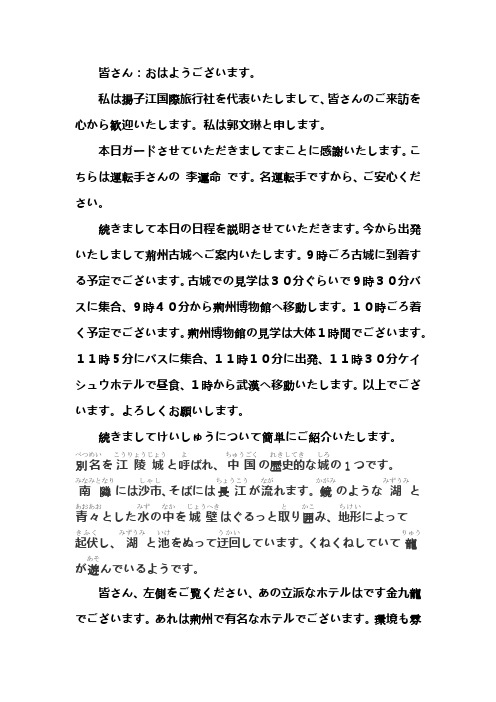
皆さん:おはようございます。
私は揚子江国際旅行社を代表いたしまして、皆さんのご来訪を心から歓迎いたします。
私は郭文琳と申します。
本日ガードさせていただきましてまことに感謝いたします。
こちらは運転手さんの 李運命 です。
名運転手ですから、ご安心ください。
続きまして本日の日程を説明させていただきます。
今から出発いたしまして荊州古城へご案内いたします。
9時ごろ古城に到着する予定でございます。
古城での見学は30分ぐらいで9時30分バスに集合、9時40分から荊州博物館へ移動します。
10時ごろ着く予定でございます。
荊州博物館の見学は大体1時間でございます。
11時5分にバスに集合、11時10分に出発、11時30分ケイシュウホテルで昼食、1時から武漢へ移動いたします。
以上でございます。
よろしくお願いします。
続きましてけいしゅうについて簡単にご紹介いたします。
別名べつめいを江陵城こうりょうじょうと呼よばれ、中国ちゅうごくの歴史的れきしてきな城しろの1つです。
南隣みなみとなりには沙市しゃし、そばには長江ちょうこうが流ながれます。
鏡かがみのような湖みずうみと青々あおあおとした水みずの中なかを城壁じょうへきはぐるっと取とり囲かこみ、地形ちけいによって起伏きふくし、湖みずうみと池いけをぬって迂回うかいしています。
くねくねしていて龍りゅうが遊あそんでいるようです。
皆さん、左側をご覧ください、あの立派なホテルはです金九龍でございます。
あれは荊州で有名なホテルでございます。
環境も雰囲気もよろしゅうございます。
はい、古城に着きました、皆さんお疲れさまでした。
ここでの見学は30分でございます9時30分にバスに集合、お願いします。
どうぞ、降りてください、私の後についてください。
巍巍古城ぎぎこじょうは、既すでに2000年余ねんあまりの歴史れきしがあり、秦漢しんかんに、城しろの周囲しゅういを造つくり、五代十国ごだいじっこくの後あとで、レンガれんがで城しろを建てました。
日本导游词(精选7篇)
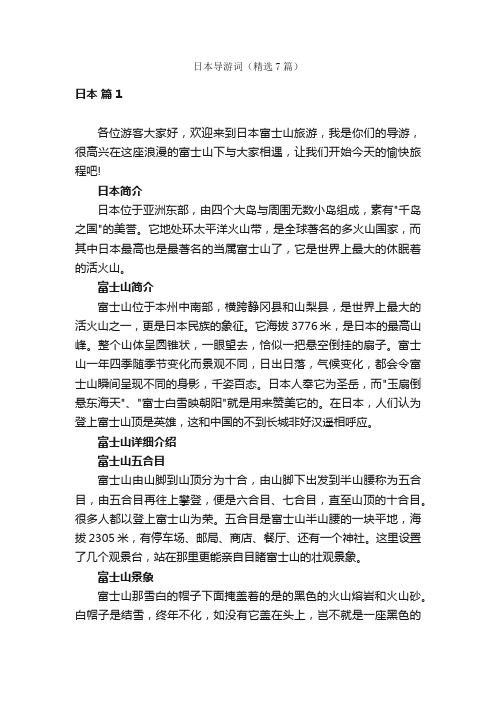
日本导游词(精选7篇)日本篇1各位游客大家好,欢迎来到日本富士山旅游,我是你们的导游,很高兴在这座浪漫的富士山下与大家相遇,让我们开始今天的愉快旅程吧!日本简介日本位于亚洲东部,由四个大岛与周围无数小岛组成,素有"千岛之国"的美誉。
它地处环太平洋火山带,是全球著名的多火山国家,而其中日本最高也是最著名的当属富士山了,它是世界上最大的休眠着的活火山。
富士山简介富士山位于本州中南部,横跨静冈县和山梨县,是世界上最大的活火山之一,更是日本民族的象征。
它海拔3776米,是日本的最高山峰。
整个山体呈圆锥状,一眼望去,恰似一把悬空倒挂的扇子。
富士山一年四季随季节变化而景观不同,日出日落,气候变化,都会令富士山瞬间呈现不同的身影,千姿百态。
日本人奉它为圣岳,而"玉扇倒悬东海天"、"富士白雪映朝阳"就是用来赞美它的。
在日本,人们认为登上富士山顶是英雄,这和中国的不到长城非好汉遥相呼应。
富士山详细介绍富士山五合目富士山由山脚到山顶分为十合,由山脚下出发到半山腰称为五合目,由五合目再往上攀登,便是六合目、七合目,直至山顶的十合目。
很多人都以登上富士山为荣。
五合目是富士山半山腰的一块平地,海拔2305米,有停车场、邮局、商店、餐厅、还有一个神社。
这里设置了几个观景台,站在那里更能亲自目睹富士山的壮观景象。
富士山景象富士山那雪白的帽子下面掩盖着的是的黑色的火山熔岩和火山砂。
白帽子是结雪,终年不化,如没有它盖在头上,岂不就是一座黑色的秃山。
据传那是在公元前286年因地震而形成的。
自公元781年有文字记载以来,共喷发过18次,最后一次是1707年,听说由于火山喷发,富士山在山麓处形成了无数山洞,有的山洞至今仍有喷气现象。
富士山山顶有大小两个火山口,大火山口,直径约800米、深200米。
富士山小御岳神社小御岳是富士山形成以前就存在的古老的山岳。
小御岳和古富士为台基,经过多次火山喷发、形成了如今的富士山。
导游资格考试英语导游词:日本.doc
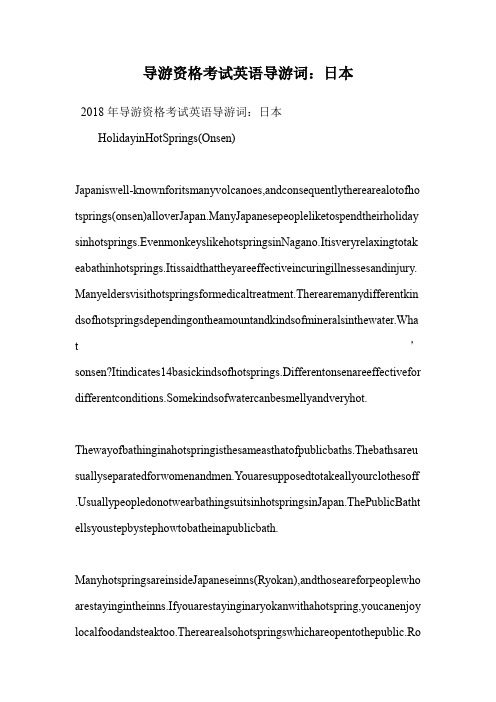
导游资格考试英语导游词:日本2018年导游资格考试英语导游词:日本HolidayinHotSprings(Onsen)Japaniswell-knownforitsmanyvolcanoes,andconsequentlytherearealotofho tsprings(onsen)alloverJapan.ManyJapanesepeopleliketospendtheirholiday sinhotsprings.EvenmonkeyslikehotspringsinNagano.Itisveryrelaxingtotak eabathinhotsprings.Itissaidthattheyareeffectiveincuringillnessesandinjury. Manyeldersvisithotspringsformedicaltreatment.Therearemanydifferentkin dsofhotspringsdependingontheamountandkindsofmineralsinthewater.Wha t’sonsen?Itindicates14basickindsofhotsprings.Differentonsenareeffectivefor differentconditions.Somekindsofwatercanbesmellyandveryhot.Thewayofbathinginahotspringisthesameasthatofpublicbaths.Thebathsareu suallyseparatedforwomenandmen.Youaresupposedtotakeallyourclothesoff .UsuallypeopledonotwearbathingsuitsinhotspringsinJapan.ThePublicBatht ellsyoustepbystephowtobatheinapublicbath.ManyhotspringsareinsideJapaneseinns(Ryokan),andthoseareforpeoplewho arestayingintheinns.Ifyouarestayinginaryokanwithahotspring,youcanenjoy localfoodandsteaktoo.Therearealsohotspringswhichareopentothepublic.Rotenburo(openairbaths),whereyoucanseebeautifulnatureviewsareverypopul ar.SoakingupJapan’sHotSpringsbyRachelFarnayshowsyouvariousscenesfromavisittoaJapanes einnwithrotenburo.Dave’sNaturalandTraditionalHotSpringsofJapanisacollectionofpicturesfromhots pringsalloverJapan.JapaneseSkiResortsSkiingisaverypopularwintersportinJapan,andtherearemanyskiresortsyouca nvisit.MostofthefamousJapaneseskiresortsarelocatedintheChucubregionan dHakubaareainNagano(Chuburegion)isoneofthem.Inthe1998Downhill,Su perG,Jumping,Biathlon,andCrossCountrycompetitionswereheldthere.SkiinginJapancanbecostlyforyousincetheaccommodations,food,andlifttick etstendtobeexpensive.However,ifyoustayatMinshuku,whichisaprivategues thouse,thecostischeaper.Therearemanyminshukuaroundanyskiresort.Itisag oodideatovisitthelocalKankouAnnai-jo(Touristinformationcenter).Theyus uallyhavealistofminshukuintheirareas.CampinginJapanAscampinghasbecomeapopularleisureactivityamongJapanesepeople,hund redsofcampgroundshavebeenbuiltalloverthecountry.Campgroundsarecalledcamp-joinJapan.Also,campgroundswhichhasRVsitesarecalledautocamp-j o.Thepricevariessitebysite,buttheaveragecampingfeeforafamilywithaRVis about5000yenpernight.Mostoftheautocamp-joinJapanofferfacilitiesseenint hecampgroundsinNorthAmerica,suchasshowerrooms,restrooms,sewer,ele ctricity,water,andsoon.Someevenhavehotsprings!Ifyouplantostayinacampgroundduringthesummer(JulyandAugust)oronwee kends,earlyreservationsarerecommended.Therearecheck-outandcheck-inti mesineachcampground.Makesuretoaskthetimeswhenyoumakereservations .Also,duringtheoffseason,manycampgroundsareclosed.FunatTokyoDisneylandTokyoDisneylandisthemostfamousamusementparkinJapan.Thisparkisfille dwithmanypeoplethroughouttheyear-thereisnooff-seasonhere.Ithinkbotha dultsandchildrenenjoythefuninTokyoDisneyland.Ifyou’vebeentoDisneylandintheUnitedStates,itmightbeafunexperiencetocompar ethedifferencesandsimilaritiesbetweenthetwoparks.ImageMickeyMousesp eakingtoyouinJapanese!TokyoDisneylandislocatedinUrayasu,Chiba.ItisrightoutsideofTokyo.Theb estwaytogetthereisbytakingtheJRKeiyolinetrainfromTokyotoMaihamastat ion.Thenitisonlya10min.walkfromMaihamastationtoTokyoDisneyland.TokyoDisneyland’sOfficialhomepagetellsyoumoreaccessinformation.Thegeneraladmissionticketcostis3,670yenforanadult.Ifyouareplanningtous emanyoftheattractions,gettingaPassportisagoodidea.Itcosts5,200yenforana dultandincludesallattractions.ThereisaStarlightPassport(4,180yen/anadult) foradmissiontotheparkafter5:00p.m.oncertaindays.Moredetailedticketinfo rmationfromTokyoDisneyland’sofficialhomepageisavailable.Thoseticketsaresoldinthemainentranceofthe park,butusuallythereisalongwaitingline.Itmightsaveyourtimeifyoupurchas eticketsinadvance.TicketscanbepurchasedfromtravelagenciesinJapan.Also ,TokyoDisneylandcenterislocatedinHibiyaMitsuiBuildinginHibiyastation, Tokyo.ClimbingMt.FujiManyJapanesepeopledreamofclimbingMt.Fujionceintheirlives.Mt.Fujiisth etallestmountaininJapan(3776m-12290feet),andJapanesepeoplelovethemo untain,callingitasFuji-san.It’slocatedabout60milessouthwestofTokyoinShizuokaandYamanashiprefectu res.TheofficialclimbingseasonforMt.FujiisfromJuly1totheendofAugust.Mt.Fu jiSafetyCenterisopenatthe6thStationduringtheclimbingseason(0555-24-6223).Althoughalltrailsgetreallycrowded,it’sbesttoclimbMt.Fujiatthistimeofyear.Theoffseasonclimbisdiscouragedduet othebadclimate.It’ssaidthatabout300,000peopletrytoclimbMt.Fujieveryyearandthat30-40%o fthemareforeignvisitors.JohnLennonMuseumSincetheJohnLennonmuseumopenedonOctober9in2000,manyfansandtouri stsfromtheworldhavevisitedthemuseum.It’slocatedinSaitamaprefecture,JapanandisclosetoTokyo.JohnLennon’swidow,YokoOno,approvedthismuseumastheworld’sfirstmuseumtohonorJohnLennon.YokoOnovisitedthismuseumforaspecial eventinJune,2001.It’sawonderfulmuseum,whichisworthavisit.Themuseumexhibitsmorethan100items,includingJohnLennon’sguitars,handwrittenlyrics,stagecostumes,photos,andlotsmore.Itemsaredis playedinchronologicalorderfromJohnLennon’sbirthtotheendoflife.Inadditiontotheseregularexhibitions,themuseumoffers specialexhibitions.。
日本导游词范文介绍

日本导游词范文介绍日本(Japan,全称:日本国),位于亚洲东部、太平洋西北。
国名意为“日出之国”,领土由北海道、本州、四国、九州四大岛及7200多个小岛组成,总面积37.8万平方千米。
主体民族和族,通用日语。
以下是为大家整理的日本导游词范文介绍,供大家参考学习。
日本导游词1各位游客,大家好,欢迎大家来到札幌观光游览,我是你们的导游,很高兴在这祥和的日子里与大家相遇,希望我的解说能给大家带来一次愉快的旅行体验!如同大部分北海道地区的地名由来,"札幌"这地名也是起源于北海道当地的原住民阿伊努族的语言阿伊努语,经过和化之后,以日语的呈现。
札幌位于北海道石狩平原西南部,是个典型的北国城市,具有浓厚的北国风味。
市区沿平川的河道伸展,人行道上种满了洋槐树,因而札幌又素有"洋槐之都"的美誉。
札幌冰雪节、冬季奥运会、冬季亚运会等国际盛会都曾经在札幌召开。
札幌作为一个国际性的大都会而闻名于世。
在美食方面,札幌的拉面堪称全北海道最大特色,到这里不得不尝一尝。
这里年平均气温为8.2摄氏度,最高气温为31.9摄氏度,最低气温为-14.4摄氏度,四季分明。
春天可以在大通公园看到紫丁香与铃兰一起绽开的绚景,夏天在蔚蓝的天空下可与羊之丘展望台四溢的清爽绿色拥抱,秋天可漫步于北海道大学金黄色的银杏林荫道,冬天则可融入国际滑雪场白茫茫的世界。
一、北海道神宫北海道神宫位于札幌市中央区,是北海道社格最高的神社。
这里主要供奉着四柱神,即:大国魂神、大那牟迟神、少彦名神。
二、狸小路商店街日本北海道札幌市中央区的狸小路商店街是一条着名商店街。
狸小路一带是相当繁荣的商店集中地,通常简称"狸小路"。
狸小路是位于札幌市中心南2条~3条至西1~7丁目一带的北海道最大的商店街,拥有百年以上的历史,分7个街区,长1公里,由地铁南北线簿野站下车徒步8分钟可至。
狸小路商店几乎与簿野一带的繁华街连成一片,宽敞干净,头顶是玻璃天棚,明朗透亮,购物环境舒适。
京都 英文导游词
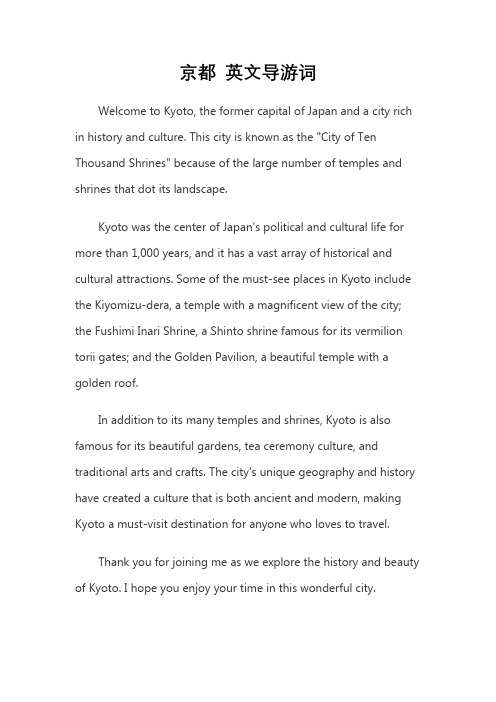
京都英文导游词Welcome to Kyoto, the former capital of Japan and a city rich in history and culture. This city is known as the "City of Ten Thousand Shrines" because of the large number of temples and shrines that dot its landscape.Kyoto was the center of Japan's political and cultural life for more than 1,000 years, and it has a vast array of historical and cultural attractions. Some of the must-see places in Kyoto include the Kiyomizu-dera, a temple with a magnificent view of the city; the Fushimi Inari Shrine, a Shinto shrine famous for its vermilion torii gates; and the Golden Pavilion, a beautiful temple with a golden roof.In addition to its many temples and shrines, Kyoto is also famous for its beautiful gardens, tea ceremony culture, and traditional arts and crafts. The city's unique geography and history have created a culture that is both ancient and modern, making Kyoto a must-visit destination for anyone who loves to travel.Thank you for joining me as we explore the history and beauty of Kyoto. I hope you enjoy your time in this wonderful city.。
东京导游词
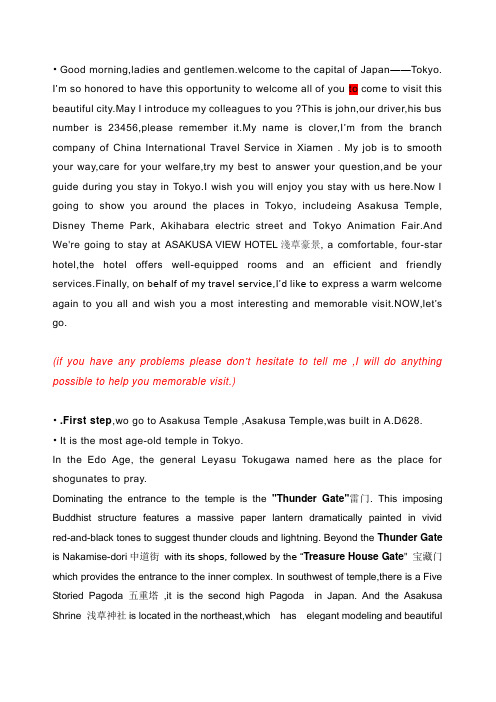
• Good morning,ladies and gentlemen.welcome to the capital of Japan——Tokyo. I’m so honored to have this opportunity to welcome all of you to come to visit this beautiful city.May I introduce my colleagues to you ?This is john,our driver,his bus number is 23456,please remember it.My name is clover,I’m from the branch company of China International Travel Service in Xiamen .My job is to smooth your way,care for your welfare,try my best to answer your question,and be your guide during you stay in Tokyo.I wish you will enjoy you stay with us here.Now I going to show you around the places in Tokyo, includeing Asakusa Temple, Disney Theme Park, Akihabara electric street and Tokyo Animation Fair.And We're going to stay at ASAKUSA VIEW HOTEL淺草豪景, a comfortable, four-star hotel,the hotel offers well-equipped rooms and an efficient and friendly services.Finally, o n behalf of my travel service,I’d like to express a warm welcome again to you all and wish you a most interesting and memorable visit.NOW,let’s go.(if you have any problems please don’t hesitate to tell me ,I will do anything possible to help you memorable visit.)•.First step,wo go to Asakusa Temple ,Asakusa Temple,was built in A.D628. • It is the most age-old temple in Tokyo.In the Edo Age, the general Leyasu Tokugawa named here as the place for shogunates to pray.Dominating the entrance to the temple is the "Thunder Gate"雷门. This imposing Buddhist structure features a massive paper lantern dramatically painted in vivid red-and-black tones to suggest thunder clouds and lightning. Beyond the Thunder Gate is Nakamise-dori中道街with its shops, followed by the “Treasure House Gate" 宝藏门which provides the entrance to the inner complex. In southwest of temple,there is a Five Storied Pagoda五重塔,it is the second high Pagoda in Japan. And the Asakusa Shrine 浅草神社is located in the northeast,which has elegant modeling and beautifulcarving. The main hall of Asakusa temple is called the Guanyin Hall观音堂,which is the largest palace in Japan and is famous for its beautiful construction.•Second step,W e are going to Disney Theme Park .The most famous landmark for kids is the Disney Theme Park in Tokyo. It is the largest Theme Park in Asia and was modeled on American Disney Park.•T here are seven themed areas in the park: the World Bazaar; the four classic Disney lands: Adventureland, Westernland, Fantasyland and Tomorrowland;and two mini-lands: Critter Country and Mickey's Toontown. The park is noted for its extensive open spaces, to accommodate the large crowds that visit the park.[3. • There are two features of it. First, the Disney Theme Park created everything movable. Second, all the parks continue renewing every year.You can enjoy yourself very well there and after visit Disney Theme Park,we will have a dinner in their hotel then enjoy the night view and also can buy some souvenirs in their store,.And the ticket prices vary from one package to another,and I will tell you later..• .Third step,we visit Akihabara electric street, Akihabara is a district in central Tokyo, famous for its many electronics shops. In recent years, it has also gained fame as a center of the gaming赌博, manga and animation culture.Hundreds of electronics shops of various sizes can be found around Akihabara Station and along Chuo Dori (Chuo Avenue).••Forth step,we go to see the Tokyo Animation Fair.Tokyo Animation Fair is the most influential anime conventions大会in the world.• You can see cosplayers strut their stuff every where.。
- 1、下载文档前请自行甄别文档内容的完整性,平台不提供额外的编辑、内容补充、找答案等附加服务。
- 2、"仅部分预览"的文档,不可在线预览部分如存在完整性等问题,可反馈申请退款(可完整预览的文档不适用该条件!)。
- 3、如文档侵犯您的权益,请联系客服反馈,我们会尽快为您处理(人工客服工作时间:9:00-18:30)。
导游资格考试英语导游词:日本Holiday in Hot Springs (Onsen)Japan is well-known for its many volcanoes and consequently there are a lot of hot springs (onsen) all over Japan. Many Japanese people like to spend their holidays in hot springs. Even monkeys like hot springs in Nagano. It is very relaxing to take a bath in hot springs. It is said that they are effective in curing illnesses and injury. Many elders visit hot springs for medical treatment. There are many different kinds of hot springs depending on the amo unt and kinds of minerals in the water. What’s onsen? It indicates 14 basic kinds of hot springs. Different onsen are effective for different conditions. Some kinds of water can be smelly and very hot.The way of bathing in a hot spring is the same asthat of public baths. The baths are usually separated for women and men. You are supposed to take all your clothes off. Usually people do not wear bathing suits in hot springs in Japan. The Public Bath tells you step by step how to bathe in a public bath.Many hot springs are inside Japanese inns (Ryokan) and those are for people who are staying in the inns. If you are staying in a ryokan with a hot spring you canenjoy local food and steak too. There are also hot springs which are open to the public. Roten buro (open air baths) where you can see beautiful nature views are very popular. Soaking up Japan’s Hot Springs by Rachel Farnay shows you various scenes from a visit to a Japanese inn with roten buro. Dave’s Natural and Traditional Hot Springs of Japan is a collection of pictures from hot springs all over Japan.Japanese Ski ResortsSkiing is a very popular winter sport in Japan and there are many ski resorts you can visit. Most of the famous Japanese ski resorts are located in the Chucub region and Hakuba area in Nagano (Chubu region) is one of them. In the 1998 Downhill Super G Jumping Biathlon and Cross Country competitions were held there.Skiing in Japan can be costly for you since the accommodations food and lift tickets tend to be expensive. However if you stay at Minshuku which is a private guest house the cost is cheaper. There are many minshuku around any ski resort. It is a good idea to visit the local Kankou Annai-jo (Tourist information center). They usually have a list of minshuku in their areas.Camping in JapanAs camping has become a popular leisure activity among Japanese people hundreds of campgrounds havebeen built all over the country. Campgrounds are called camp-jo in Japan. Also campgrounds which has RV sites are called auto camp-jo. The price varies site by site but the average camping fee for a family with a RV is about 5000 yen per night. Most of the auto camp-jo in Japan offer facilities seen in the campgrounds in North America such as shower rooms restrooms sewer electricity water and so on. Some even have hot springs!If you plan to stay in a campground during the summer (July and August) or on weekends early reservations are recommended. There are check-out and check-in times in each campground. Make sure to ask the times when you make reservations. Also during the off season many campgrounds are closed.Fun at Tokyo DisneylandTokyo Disneyland is the most famous amusement park in Japan. This park is filled with many people throughout the year - there is no off-season here. I think both adults and children enjoy the fun in Tokyo Disneyland. If you’ve been to Disneyland in the United States it might be a fun experience to compare the differences and similarities between the two parks. Image Mickey Mouse speaking to you in Japanese!Tokyo Disneyland is located in Urayasu Chiba. It is right outside of Tokyo. The best way to get there is bytaking the JR Keiyo line train from Tokyo to Maihama station. Then it is only a 10 min. walk from Maihama station to Tokyo Disneyl and. Tokyo Disneyland’s Official home page tells you more access information.The general admission ticket cost is 3670 yen for an adult. If you are planning to use many of the attractions getting a Passport is a good idea. It costs 5200 yen for an adult and includes all attractions. There is a Starlight Passport (4180 yen/an adult) for admission to the park after 5:00 p.m. on certain days. More detailed ticket information from Tokyo Disneyland’s official home page is available. Those tickets are sold in the main entrance of the park but usually there is a long waiting line. It might save your time if you purchase tickets in advance. Tickets can be purchased from travel agencies in Japan. Also Tokyo Disney land center is located in Hibiya Mitsui Building in Hibiya station Tokyo.Climbing Mt. FujiMany Japanese people dream of climbing Mt. Fuji once in their lives. Mt. Fuji is the tallest mountain in Japan (3776m - 12290 feet) and Japanese people love the mountain calling it as Fuji-san. It’s located abo ut 60miles southwest of Tokyo in Shizuoka and Yamanashi prefectures.The official climbing season for Mt. Fuji is from July 1 to the end of August. Mt. Fuji Safety Center is open at the 6th Station during the climbing season (0555-24-6223). Although all trails get really crowded it’s best to climb Mt. Fuji at this time of year. The off season climb is discouraged due to the bad climate. It’s said that about 300000 people try to climb Mt. Fuji every year and that 30-40% of them are foreign visitors.John Lennon MuseumSince the John Lennon museum opened on October 9 in 2000 many fans and tourists from the world have visited the museum. It’s located in Saitama prefecture Japan and is close to Tokyo. John Lennon’s widow Yoko Ono approved this museum as th e world’s first museum to honor John Lennon. Yoko Ono visited this museum for a special event in June 2001. It’s a wonderful museum which is worth a visit.The museum exhibits more than 100 items including John Lennon’s guitars handwritten lyrics stage c ostumes photos and lots more. Items are displayed in chronological order from John Lennon’s birth to the end of life. In addition to these regular exhibitions the museum offers special exhibitions.。
